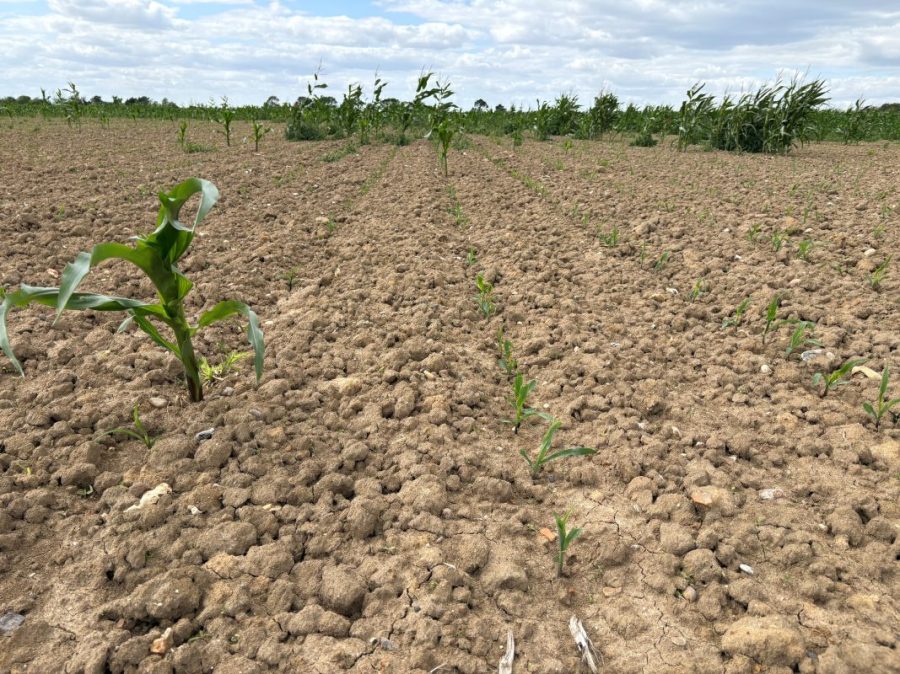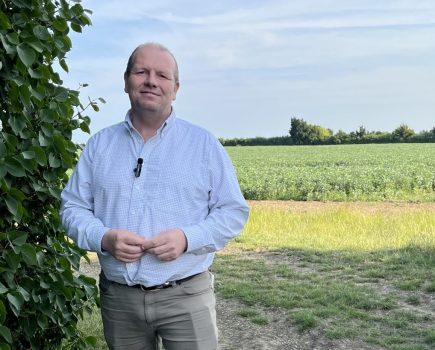By Guy Smith
I know I’m not the only one who won’t remember 2025 for its benign weather. The scale of this meteorological adversity is neatly illustrated by the accompanying image of my neighbour’s maize…
Drilled in April, into dry, cobbly conditions, most of the seed sat in dust waiting for rain that took more than three months to arrive. It was as if the weather gods were playing with farming nerves by waiting until mid-July before sending sufficient moisture to chit 75% of the seed, thereby assuring the crop would emerge too late to come to anything.
Had the rain arrived a few weeks earlier, the crop might have come to something. I’ve not witnessed an August-emerged maize crop before so this’ll be one to watch.
As an arable farmer on the other side of the fence, the piercing spring drought that broke once the wheat was ripe in mid-July, also felt like the weather was in a spiteful mood. It reminded me of the old saying: ‘If you want it to rain then get the combine out of the machinery store’. If there’s another drought next year then I’ll make sure to park it up outside in early June.
So Harvest 2025 won’t go down as a bumper one. The early-sown wheat on heavier land performed reasonably – 8-9t/ha – but on lighter land it was half that. In the same vein, anything sown late after sugar beet performed badly.
Alongside poor yields we have poor prices. It doesn’t take too much head-scratching to realise this harvest was one where it simply wasn’t worth the bother or expense. Taking my gaze off the red figures and negative margins – trying to find my glass half full – it was probably the right year for us to have more than half of the farm in SFI and Countryside Stewardship schemes.
What’ll really concentrate the mind will be when 2027 comes around and most of the schemes finish. At the moment there seems little indication what the successors will look like and when they’ll be open for business. 2026 could be a pensive year.
Another more immediate question is what to sow this autumn. Following three years of abstinence I’m minded to return to oilseed rape. The price seems attractive and the optimist in me suggests it’s not going to be a bad cabbage stem flea beetle year. Even so, we’ll require adequate rain to get the crop up and away in August; at the time of writing, there’s none on the horizon.
Surely the weather won’t maintain its 2025 contrariness by delaying rain until October, by which time it’ll be too late for OSR. I’m hoping for a change of luck, failing that there’s always therapy.
Care and kindness
There seems to be a disturbing amount of talk regarding farmer suicides in light of the changes to IHT being brought in next April. As an industry, we must be careful how we frame this; the temptation is to see it as part of our lobbying argument.
It’s almost as if some might see farmers taking their own lives as a useful point when it comes to why the policy should be changed. What has to be remembered is that this is an argument that flirts with the idea that it’s understandable why some old and frail farmers might be thinking of doing the unthinkable.
We should all remember that even if farmers might be approaching their final decade, it doesn’t make them some sort of liability. Our elders should be loved and cherished rather than being seen as some sort of tax risk. It’s time to take a rain check and to think about what we’re saying and how that might impact on others.
This article was taken from the latest issue of CPM. Read the article in full here.
For more articles like this, subscribe here.
Sign up for Crop Production Magazine’s FREE e-newsletter here.




